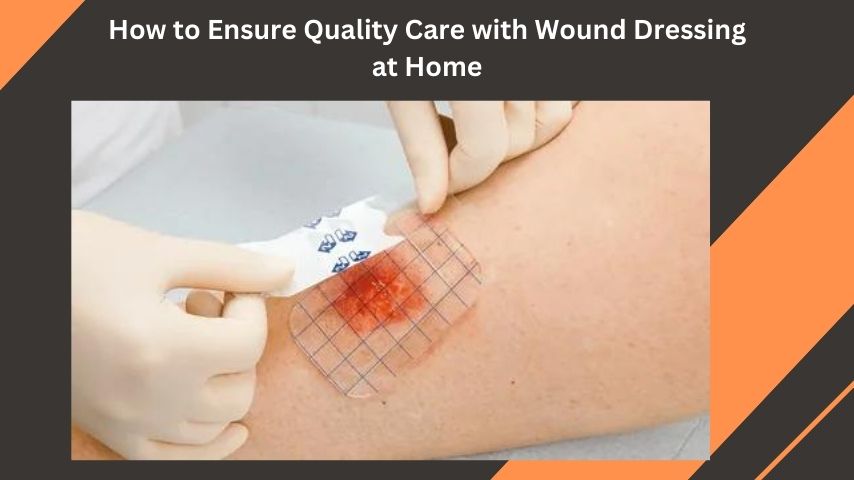Proper wound care is essential for healing and preventing complications such as infections. With the right approach and knowledge, you can effectively manage wound dressing at home. This blog will guide you through the steps to ensure quality care, making the process straightforward and manageable.
Additionally: For more information on wound dressing at home and to access expert guides and resources, visit our website. Start improving your home care techniques today and ensure a speedy recovery for yourself or your loved ones with quality wound dressing at home!
Understanding the Importance of Wound Dressing
Wound dressing involves covering a wound to protect it from infection and further injury. It helps in absorbing exudate (fluid that leaks from the wound), keeping the wound moist, and promoting healing.

Benefits of Proper Wound Dressing at Home
- Prevents Infection: A properly dressed wound is less likely to become infected.
- Reduces Pain: Covering a wound can protect nerve endings and reduce pain.
- Speeds Up Healing: A moist, protected environment promotes faster healing.
- Minimizes Scarring: Proper care can reduce the formation of scars.
Steps to Ensure Quality Wound Dressing at Home
To effectively dress a wound at home, follow these steps:
1. Gather Necessary Supplies
Having the right supplies on hand is crucial. Ensure you have:
- Sterile Gauze Pads: To cover the wound.
- Antiseptic Solution: For cleaning the wound.
- Medical Tape: To secure the dressing.
- Antibiotic Ointment: To prevent infection.
- Gloves: To maintain a sterile environment.
2. Wash Your Hands
Always wash your hands thoroughly with soap and water before and after touching a wound. This step is vital to prevent introducing bacteria into the wound.
3. Clean the Wound
Use an antiseptic solution to clean the wound gently. This step helps remove any debris and reduces the risk of infection.
4. Apply Antibiotic Ointment
Apply a thin layer of antibiotic ointment to the wound. This helps to prevent infection and keeps the wound moist, promoting healing.
5. Cover with Sterile Gauze
Place a sterile gauze pad over the wound. Make sure the pad is large enough to extend beyond the edges of the wound to ensure complete coverage.
6. Secure the Dressing
Use medical tape to secure the gauze pad in place. Ensure the tape is not too tight, as this can restrict blood flow and delay healing.
7. Change the Dressing Regularly
Change the wound dressing at least once a day or whenever it becomes wet or dirty. Regular changing helps prevent infection and allows you to monitor the wound’s healing progress.
Common Mistakes to Avoid
While dressing a wound at home, avoid these common mistakes:
Using Non-Sterile Materials
Always use sterile materials to avoid introducing bacteria into the wound.
Applying Too Much Ointment
While antibiotic ointment is beneficial, applying too much can prevent the dressing from absorbing wound exudate properly.
Securing the Dressing Too Tightly
Tight dressings can cut off blood circulation. Ensure the dressing is snug but not constricting.
Not Changing the Dressing Regularly
Neglecting to change the dressing can lead to infection and delayed healing. Be diligent about regular changes.
Why Quality Wound Dressing at Home Matters
Quality wound dressing at home is critical for several reasons:
Preventing Infections
Infections can complicate and prolong the healing process. By ensuring the wound is properly cleaned and dressed, you significantly reduce the risk of infection.
Promoting Faster Healing
A well-dressed wound heals faster. The right environment (moist and protected) allows the body’s natural healing processes to work more efficiently.
Reducing Pain and Discomfort
Proper dressing protects nerve endings and reduces exposure to the air, which can help minimize pain and discomfort.
Minimizing Scarring
Proper wound care can reduce the likelihood of excessive scarring. Keeping the wound moist and protected promotes better skin regeneration.
Ensuring Overall Health
For individuals with chronic conditions like diabetes, proper wound care is essential to prevent complications such as ulcers or severe infections that can lead to more serious health issues.
Special Considerations for Different Types of Wounds
Different wounds require different care. Here’s how to handle a few common types:
Minor Cuts and Scrapes
For minor cuts and scrapes, clean the wound with water and mild soap, apply an antibiotic ointment, and cover with a bandage.
Deep Cuts
For deeper cuts that might require stitches, it’s best to seek professional medical advice. If dressing at home, ensure the wound is thoroughly cleaned, apply an antibiotic ointment, and use a larger, more absorbent dressing.
Burns
Burns require special care. For minor burns, rinse with cool water, apply a burn ointment, and cover with a non-stick sterile dressing. Avoid applying ice directly to the burn.
Surgical Wounds
Follow the specific instructions provided by your healthcare provider for surgical wounds. Typically, these involve more meticulous cleaning and dressing procedures to prevent infection.
When to Seek Professional Help
While home care is suitable for many wounds, some situations require professional medical attention:
Signs of Infection
Seek medical help if you notice signs of infection such as increased redness, swelling, warmth, pus, or a foul odor.
Excessive Bleeding
If the wound continues to bleed heavily after applying pressure for several minutes, seek medical assistance immediately.
Deep or Large Wounds
Deep or large wounds, especially those caused by animal bites or rusty objects, should be evaluated by a healthcare professional.
Non-Healing Wounds
If a wound is not showing signs of healing within a few days, consult a healthcare provider. Non-healing wounds can indicate underlying health issues.
Conclusion
Ensuring quality care with wound dressing at home involves gathering the right supplies, following proper steps, avoiding common mistakes, and knowing when to seek professional help. By doing so, you can promote faster healing, prevent infections, reduce pain, and minimize scarring.
For more insightful articles related to this topic, feel free to visit findtec.






